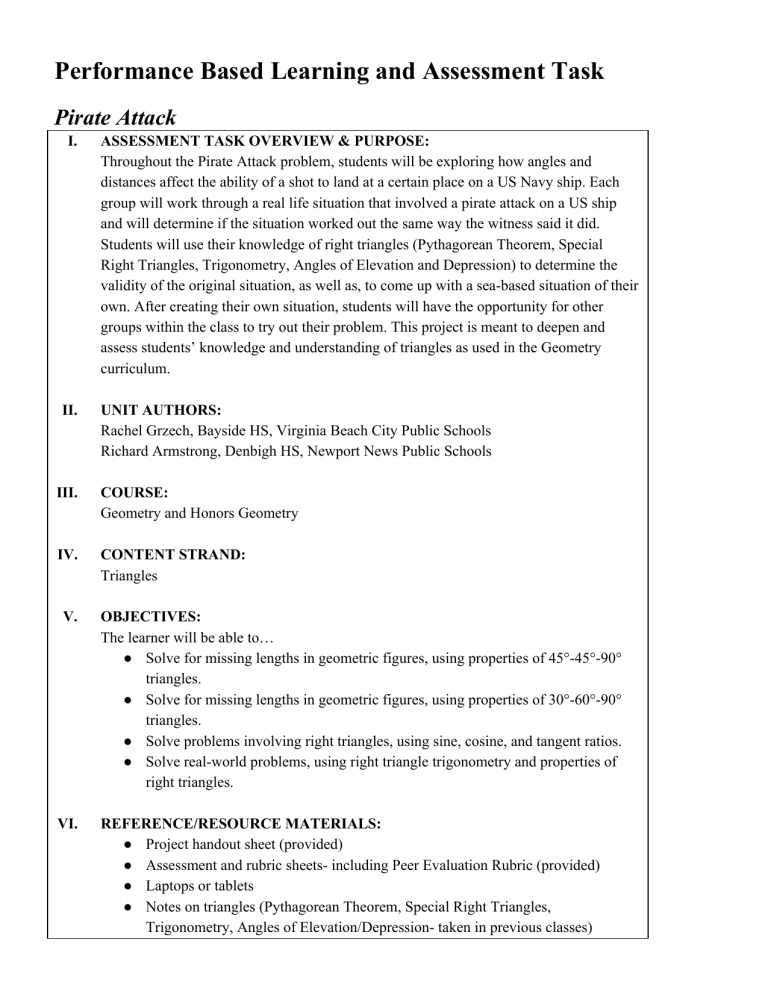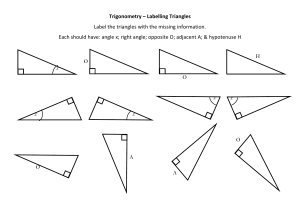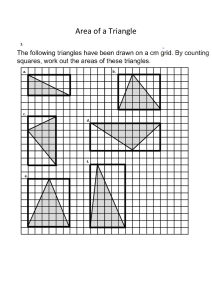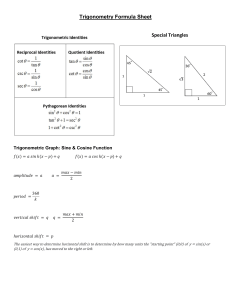
Performance Based Learning and Assessment Task Pirate Attack I. II. ASSESSMENT TASK OVERVIEW & PURPOSE: Throughout the Pirate Attack problem, students will be exploring how angles and distances affect the ability of a shot to land at a certain place on a US Navy ship. Each group will work through a real life situation that involved a pirate attack on a US ship and will determine if the situation worked out the same way the witness said it did. Students will use their knowledge of right triangles (Pythagorean Theorem, Special Right Triangles, Trigonometry, Angles of Elevation and Depression) to determine the validity of the original situation, as well as, to come up with a sea­based situation of their own. After creating their own situation, students will have the opportunity for other groups within the class to try out their problem. This project is meant to deepen and assess students’ knowledge and understanding of triangles as used in the Geometry curriculum. UNIT AUTHORS: Rachel Grzech, Bayside HS, Virginia Beach City Public Schools Richard Armstrong, Denbigh HS, Newport News Public Schools III. COURSE: Geometry and Honors Geometry IV. CONTENT STRAND: Triangles V. VI. OBJECTIVES: The learner will be able to… ● Solve for missing lengths in geometric figures, using properties of 45°­45°­90° triangles. ● Solve for missing lengths in geometric figures, using properties of 30°­60°­90° triangles. ● Solve problems involving right triangles, using sine, cosine, and tangent ratios. ● Solve real­world problems, using right triangle trigonometry and properties of right triangles. REFERENCE/RESOURCE MATERIALS: ● Project handout sheet (provided) ● Assessment and rubric sheets­ including Peer Evaluation Rubric (provided) ● Laptops or tablets ● Notes on triangles (Pythagorean Theorem, Special Right Triangles, Trigonometry, Angles of Elevation/Depression­ taken in previous classes) ● ● ● ● Geometry Textbook Calculators Poster board (1 per group) Poster decorating materials as provided or requested per group. VII. PRIMARY ASSESSMENT STRATEGIES: Attached is the Assessment List and Rubric for the Pirate Attack Project. The goal of the activity is to deepen and assess the students’ understanding of triangles (G.8 VA SOL specifically) by exploring a real life situation and creating a situation of their own. Using the attached documents, student assessment will focus on the completion of the task; how the work has been presented; if the student is able to explain their work, process and results through the products created; and the accuracy of their conclusions and diagrams. A portion will also come from the problem they create and complete. Each group will create a problem for their classmates using the triangles material discussed previously. Each student will be asked to complete a different group’s problem and will receive a portion of their overall score from that piece. VIII. EVALUATION CRITERIA: Students will be evaluated on the correctness of their findings for the original problem, their ability to present their findings in a meaningful and coherent manner, their diagram and findings for the group­created problem, and their individual performance on the problem. Further description can be found in the attached Project Rubric. The group­created problem will be graded using a key, created by the corresponding group. All other portions will be evaluated using the Rubric. IX. INSTRUCTIONAL TIME: This project will take one to one and a half 90 minute block (s). Students will finish the original problem and complete their group­created problems and poster within the first block. The second block will be for short presentations and the completion of whichever problem they are assigned individually. 2 Pirate Attack Project Strand Geometry: Triangles Mathematical Objectives: The learner will be able to… ● Solve for missing lengths in geometric figures, using properties of 45°­45°­90° triangles. ● Solve for missing lengths in geometric figures, using properties of 30°­60°­90° triangles. ● Solve problems involving right triangles, using sine, cosine, and tangent ratios. ● Solve real­world problems, using right triangle trigonometry and properties of right triangles. This activity is meant to be used as a culminating activity for Trigonometry, Special Right Triangles, and the Pythagorean Theorem unit in Geometry. It will introduce students to using mathematical reasoning in a legal environment, proving or disproving assertions made in court. It will also allow students to demonstrate their understanding of the use of right triangles in the "real world." Related SOL ● G.8 (The student will solve real­world problems involving right triangles by using the Pythagorean Theorem and its converse, properties of special right triangles, and right triangle trigonometry.) NCTM Standards ● Apply and adapt a variety of appropriate strategies to solve problems ● Communicate mathematical thinking coherently and clearly to peers, teachers, and others ● Use trigonometric relationships to determine lengths and angle measures . Materials/Resources ● Project handout sheet (provided) ● Assessment and rubric sheets­ including Peer Evaluation Rubric (provided) ● Laptops or tablets ● Notes on triangles (Pythagorean Theorem, Special Right Triangles, Trigonometry, Angles of Elevation/Depression­ taken in previous classes) ● Geometry Textbooks ● Scientific or Graphing Calculators ● Poster board (1 per group) ● Poster decorating materials as provided or requested per group. The teacher needs to be sure to procure the appropriate technological resources in advance of giving this task in class. Assumption of Prior Knowledge Prior Knowledge ● Student should be able to "solve" a right triangle using the Pythagorean Theorem, Trigonometric ratios, and/or relationships within 30­60­90 or 45­45­90 triangles. ● Student should understand what a modern­day pirate is and their basic tactics (this may require classroom discussion) 3 ● Students should have a grasp on how to present their findings in a professional setting (i.e. as if they were speaking to a jury or hearing panel). Please incorporate this into class discussion if students need instruction on what this means. ● Students should be able to convert between different units of measure. Background: ● Students should be familiar with problems at a higher level than the basic textbook problems. They should be successfully completing problems that require some sort of independent thought and completion. This task will push them to a new level of independent mathematical processing. Possible Difficulties: ● Students may have difficulties coming up with a new situation that will actually fit the given information. Teachers should be prepared to help with some small prompts. Hopefully, this can be avoided by having students work in small groups. Relevance: ● Students should consider how unfamiliarity with the concept of triangles could affect the outcome of a court case, or how eyewitness statements may be well­intentioned, but not mathematically accurate. Introduction: Setting Up the Mathematical Task ● Briefly discuss triangles to refresh what the students already know (To include: Pythagorean Theorem, Special Right Triangles, Angles of Elevation, and Trigonometry). ● The teacher will hand out the Pirate Attack Project Handout, introduce the assignments, and have students read through the handout. o In this task, the students will determine the accuracy of an eye­witness’ testimony based on the given physical evidence. Each group will work through a given, real­life example. Students will be given two tasks. The first will be to determine (using mathematical reasoning) if the witness's testimony is credible, and if not, what changes would be necessary to make it match the physical evidence. o Each group will then create a situation of their own after doing research about current naval vessels. The group­created situations will be completed and given to other students in the class as a mini quiz to further assess group understanding. o Make students aware of the timeline: ▪ Day 1: Students will complete all mathematical calculations, create a new situation, solve situation, and create a visual to present findings and new situation to the class. ▪ Day 2: Present findings and the created situation. Complete the situation from another group that has been assigned to you. o Make students aware that any work that cannot be completed within the allowed time should be completed out of class and to please make arrangements with their groupmates. ● Open class with a discussion of pirates off the coast of Somalia and their tactics. Then introduce the specifics of the case, the specific physical evidence found, and the testimony of the witness. ● Take questions about the handout, timeline, and purpose. ● Students should be split into pairs. ● See project handout for any further questions and answer any group specific questions after breaking students up into pairs. Student Exploration Research and Preparation­ Day 1 (approximately 70 minutes) ● Assign laptops or tablets to students or take class to the computer lab. 4 ● Have students work with their partners and use the laptops to look up whatever information about ships they may want to use in their group­created situations. ● Assist students as needed to find and make decisions about what information is relevant and needed to the project. ● To integrate technology, students will be researching on their laptops, using graphing calculators and possibly Excel for calculations. ● See the project sheet for the appropriate problems and work to be completed for the rest of the block. ● As students continue to work in groups, visit each group asking how they plan to go about organizing their information, what they plan to say and do during their presentation. Assist students in making the correct assessments regarding their situations and problem setup as needed. ● Collect created problem and keys from groups. They may be electronic copies. ● If students finish with all tasks early, they may begin to practice their presentation. Presentation and Mini Quiz Day 2 (90 minutes) ● Have students prepare for their presentation. This could include: practicing their presentations quietly in groups, double checking the flow of posters, etc. (15 minutes) ● Each small group will present findings and the situation they have created. Groups will take questions from their peers and teacher. Groups are not to present the answer to their created situation. ● Students will complete a short quiz (situation) created by one of the other groups. Each group should get a different group’s quiz so that if there are 10 groups, then there are 10 different quizzes throughout the classroom. Monitoring Student Responses ● Students are expected to communicate their findings and thought process by writing down their research, keeping track of their work and creating models of the pirate situations they create within their small groups. They are then expected to present their research and results to the class both orally and visually. Each student is expected to do equal amounts of the work within the group. ● If students finish early, the teacher should ask additional questions about the situations (i.e. Where did you find dimensions for your situation? How did you come up with your situation? Does it change the problem if you are encountering rough waters?). The questions may not have exact answers, but should be used to help students think through other scenarios or complete the one they are creating. Summary (approximately 5 to 10 minutes at the beginning of the 3rd day) : ● Once the teacher grades the mini quizzes using the group provided keys, hand them back to the students. Assessment List and Benchmarks ● The required assessment list, rubric and benchmarks are attached. ● The assessments for each task are described above in the daily plan. The way those assessments will be graded is included within the Pirate Attack Project Handout. Accommodations: ● Students in need of read­aloud services will be sent to resource to have their quiz read to them, if an inclusion teacher is not available. 5 The Case of the Failed Pirate Attack Introduction: Since the failure of the government of Somalia in the early part of the 21st Century, criminal gangs have been drafting fishermen along the Somali coast into piracy. The objective of the pirates is to take control of a ship full of cargo and hold it and its crew for ransom (a payment for release). When the criminal gangs receive the ransom money, the ship is released and the pirates are paid for their services. They then get back in their skiffs (small boats: see image to the left) and go find another ship to hijack. One such attack took place in the early hours of April 1, 2010, when a pirate attack group (PAG) opened fire on the USS Nicholas (pictured below) in the middle of the Indian Ocean, about 570 nautical miles off the coast of Somalia (they obviously weren't the brightest pirates available, attacking a US warship with their tiny skiffs). Needless to say, this pirate attack was a failure! The pirates were captured and brought back to the United States to stand trial. The Navy subsequently held a hearing to determine what happened during the encounter. One witness was on watch in the CIC (Combat Information Center, also called "Combat") when the attack happened. She said that she saw a o pirate holding his AK­47 at a 45 angle pointing up towards the ship. She also stated the pirate appeared to be about 100 yards away from the ship. When the ship was inspected, a bullet hole was discovered in the mast, about 150 feet above the waterline. This bullet hole was large, and caused by a rifle, so it is believed that the bullet hole was from the AK­47 that the pirate shot. 6 The Case of the Failed Pirate Attack Name: ___________________ Partner’s Name: ________________ This project has 2 parts. Part 1 (worth 20% of your overall grade) Your task: Determine if the witness's testimony is plausible based on the physical evidence (the bullet hole). If not, offer changes to the eyewitness account that would help it match the physical evidence. Be prepared to stand before the court (your classmates) and back up your assertions with a diagram and mathematical proof. You will be asked to present your findings on Day 2. Part 2 (worth 80% of your overall grade: 60% creation of situation, 20% completion of another group’s situation) Your task: Develop your own scenario using what you have learned in this Triangles Unit. The scenario should be seaworthy (meaning having something to do with the water), but you can choose your own ship and create your own situation. Create a back­story for your situation to allow the reader to understand the situation fully. Please cite whatever online resources you used to create your situation. You will present your scenario to the class when you present your Part 1 findings and one of the other groups will be asked to solve it. Answers to this scenario will be due to the teacher at the end of Day 1. By the end of class (Day 1) you and your partner should turn in… a. a neatly drawn poster illustrating the scenario as described by the witness along with the math necessary to either support or rebuke the witness's testimony. b. If necessary, develop an alternate scenario that supports the physical evidence, including a neatly drawn diagram and the math to support. c. Your own developed scenario, supporting diagram, and answer. On Day 2 of this assignment, you will… a. Present your findings to the class, explaining the mathematical reasoning behind it. b. Be assigned one scenario developed by another team in the class, you will solve their scenario. c. Evaluate yourself and your partner(s) using the attached Peer Evaluation Rubric. Use what you have learned in this unit about solving right triangles, including but not limited to the Pythagorean Theorem, Special Right Triangles, and Trigonometry, to solve these problems. 7 Pirate Attack Situation, Visual, and Presentation Rubric Name: ___________________ Assessment List and Possible Points Item Number Description Points Possible 1 Student was an equal participant in all aspects of the project: research, visual /quiz creation and presentation. (Result of Peer Evaluation Rubric). 6 2 Math work was included to back up all stated calculations (could be turned in separately and not seen on the visual). 12 3 Math work is neat and organized. 6 4 Student completed a visual as requested on the project handout. 6 5 Research is evident in presentation and work. 6 6 Diagrams for any suggested changes to the original problem and created situation are included 6 7 The student’s presentation was neat, well­organized and engaging. 6 8 The student could explain their process, thoughts and reasoning well. 6 9 The student could answer the questions posed by classmates and teacher in a coherent, well­thought­out manner. 6 Total Points Possible: 8 60 Student Score of Him/Herself Teacher Score of Student Pirate Attack Presentation/Research and Created­Situation Rubric Item # Description 0 points 1 Student was an equal participant in all aspects of the project: research, visual /quiz creation and presentation. 2 Math work was included to back up all stated calculations (Worth double points­ 12 total). No additional math work included. 3 Math work is neat and organized. 4 Student completed a visual as requested on the project handout. 5 Research is evident in presentation and work. 6 3 points 6 points Scores for this portion will be based on the Peer Evaluation Rubric to be filled out by each group member. The resulting average will be out of 6 points (For example: an 85% on the Peer Evaluation would be 5.1 points). Some of the work was included and is accurate or all of the work is included but some is accurate. All of the math work was included and accurate. Work was not present or lacked organization/ neatness. Work was partially organized. Work was neat, legible, easy to follow and organized. No visual created. Visual was partially complete. Visual was complete with all needed information. No research included. Research included was incomplete or not evident. Research included was complete and evident. Diagrams for any suggested changes to the original problem and the created situation are included. No diagram included. Diagram was partially accurate. Some parts are labeled. Diagram was included, accurate, and fully labeled. 7 The student’s presentation was neat, well­organized and engaging. Presentation was not organized, lacked neatness, or was not engaging. Presentation was difficult to follow, and only partially engaging. Lacked organization. Presentation was easy to follow, neat and engaging. 8 The student could explain their process, thoughts and reasoning well. Student provides no explanation. Student provided an explanation, but was mostly inaccurate. Student explanation was accurate and flows. 9 The student could answer the questions posed by classmates and teacher in a coherent, well­thought­out manner. Did not answer questions. Answered questions, but was not accurate or confident with responses. Accurately answered questions. 9 Pirate Attack Situation Rubric ** This Rubric is for the original situation** Assessment List and Possible Points Item Number Description Points Possible 1 Completed on time. 4 2 Key to situation is mathematically accurate. 8 3 Diagram is correct and included in presentation. 8 Total Points Possible: Student Score of Him/Herself Teacher Score of Student 20 Pirate Attack Created Situation Rubric Item Number Description 0 points 4 points 8 points 1 Original situation was completed and turned in on time. (*Due end of day 1*) Problem not turned in on time. Problem was completed and turned in on time. 2 Key to situation is mathematically accurate. Key was not turned in. Key was turned in, but is not fully accurate. Key was accurate and complete. 3 Diagram is correct and included in the presentation Diagram not turned in. Diagram was included in the presentation and mostly correct.. Diagram was included and was completely accurate. The mini quiz (a different group’s created situation) you take in class will be graded using a key and will account for 20% of your project score. 10 Peer Evaluation Rubric Group Member Name(s) Total Score Directions: Place your name and your partner’s name(s) in the space above. Place the initials of your partner (or just checks) in the blanks below that BEST describe how you feel about a peer’s participation regarding each statement (Initials are easier to keep track of points if you have more than one partner). Be honest in your evaluations, rewarding someone who did not fully participate is not fair to the group. Add the points and fill in total next to names at the top. All group members’ scores will be averaged from each evaluation sheet and recorded on your product grading sheet. (Example: If you receive an 18, 20, and 13 from your group members, your score would average out to 17 out of 20 possible, which is an 85 %.) 5 points­strongly agree 4 points­very much agree 3 points­agree 2 points­somewhat agree 1 point­somewhat disagree 0 points­disagree 0 1 2 3 4 5 This person helped the group work hard to meet group objectives as listed on the project sheet. This person completed their assigned work without a having to be re­directed by group members. This person did not spend time socializing with other groups. This person listened to the other group members ideas, and offered their own input. 11 Student Benchmark 12 Team Tristan’s Situation The runway on an aircraft carrier is less than 350 feet long (most fighter­type aircraft need 2,300 feet to take off and slightly more to stop after landing). In order to stop a jet in so little space, arresting cables (a.k.a. “the wire”) are stretched out on the deck of the ship to catch a special hook on the plane. These cables pull the jets to a stop extremely fast to prevent them from falling into the ocean. You are the pilot of a F/A­18 “Hornet” jet trying to land on the carrier. You are 5000 feet from “the wire” and still 300 feet above the ship’s deck. Determine the appropriate angle of elevation from the ship to you that would be necessary for you to catch the wire and land safely on the ship. How far are you from the wire? What would happen if your angle was too big or too small? Pictures are not to scale. Websites Used to create this situation: https://illumin.usc.edu/142/taking­off­and­landing­on­an­aircraft­carrier/ (Problem Information) http://r.search.yahoo.com/_ylt=AwrB8p9Z.ahVgREAmWmQnIlQ;_ylu=X3oDMTBxNG1oMmE2BHNlYw NmcC1hdHRyaWIEc2xrA3J1cmwEaXQD/RV=2/RE=1437166042/RO=11/RU=http%3a%2f%2fcommons. wikimedia.org%2fwiki%2ffile%3auss_abraham_lincoln_side_profile.jpg/RK=0/RS=XLsEH6n66rw2KjC3l PjMYtVdLC4­ (Aircraft Carrier Picture) https://www.google.com/url?sa=i&rct=j&q=&esrc=s&source=images&cd=&cad=rja&uact=8&ved=0CAcQ jRxqFQoTCPuP9v6a4sYCFdYakgodVdkH6Q&url=http%3A%2F%2Fwww.123rf.com%2Fphoto_3644233 _f­18­hornet­army­airplane­with­gear­extended­for­landing.html&ei=_vqoVfuYHda1yATVsp_IDg&bvm= bv.98197061,d.aWw&psig=AFQjCNEvVGRjKXi4rxiDwVGSJJhzHs37qA&ust=1437224022619024 (F­18 Picture) 13 Key to Team Tristan’s Situation If your angle of elevation was too big, that means that you and the plane would be coming down towards the ship much more sharply. You might miss the back of the ship and hit the water, or you might accidentally hit the back of the ship. You might also come in at an angle so steep as to severely damage yourself, the jet, other jets, other people and the ship if you hit the flight deck wrong. If your angle is too small, you and your plane might miss the wire and land further down the carrier, not having enough time to stop. 14


